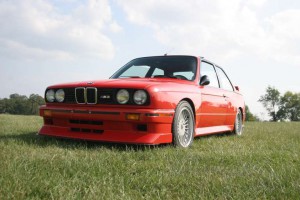
For the last twelve years, I have been the titular shepherd of the BMW E30 M3 Special Interest Group (the SIG, as we call it). The E30 M3 was the winningest car in the history of Touring Car racing. This incredibly unique car was conjured up in 1985 by then BMW M czar Paul Rosche and a team of crack engineers. It is the Shelby Cobra of BMW’s history. With the new BMW 1 Series M Coupe being touted as the next E30 M3, current BMW E30 M3 owners are wondering if a like car can be created today. What does it take for this to be possible?
Some members of the M3 SIG have made the point that one can’t build the E30 M3 today. To an extent I would agree. But really what are we talking about? The exact car? Obviously not. Such a comment begs the question – what does it take to build a car of such hallmark impact?
 The more difficult issue is one of inception conditions than one of current automotive market. The E30 M3 was borne out of a unique set of circumstances with a unique set of people. Anyone who has been deeply involved in building something of significant capability and beauty intrinsically knows what I mean. If one does not have such experience in one’s background, then I suspect my words are near meaningless. Can such an accomplishment be formula – an assemblage of specifications and parts?
The more difficult issue is one of inception conditions than one of current automotive market. The E30 M3 was borne out of a unique set of circumstances with a unique set of people. Anyone who has been deeply involved in building something of significant capability and beauty intrinsically knows what I mean. If one does not have such experience in one’s background, then I suspect my words are near meaningless. Can such an accomplishment be formula – an assemblage of specifications and parts?
The E30 M3 is an automotive experience. Like the trite saying, the whole is greater than the sum of the parts, a superb automobile is not a bunch of nuts and bolts. Nor is it created by merely picking the right nuts and bolts. That would imply a simplicity which belies the complexity of creating such a special thing. As I often like to say, art is science with too many variables. The creation of such things is high art form practiced by those with deep engineering chops and superlative craft skills.
The real questions are:
1) Is there a team of people that (as the TV show, the A-Team would say), “have the jazz” to make something special?
The once Technical Director of BMW Motorsport, Paul Rosche, was a special breed; he had a knack for many things, including not suffering fools. He assembled outstanding teams. His leadership is rare and its impact profound. Anyone who has been in such a situation, being led by such an individual (that experience places one in a small minority), knows the potential for accomplishing great things.
2) Is there a strong enough unifying goal to keep the team focused to the end product?
Winning Touring Car championships was the goal for the E30 M3. Its homologation circumstances (along with its strict rules around aerodynamics and such) gave us the street going version, with minimum deviations from the race car to make it street worthy. 60 national titles for the BMW M3 between 1987 and 1992 tells of its success.
3) Can such a project be pushed through, without significant outside mucking about?
The above #1 & #2 play significantly into #3. If 1 Series M Coupe is a marketing exercise, I will not discount the possibility to produce a like car, but I’d put short money on the bet.
In the early 1970’s, the coveted BMW 2002 arguably launched BMW’s modern vision of the Sedan. Many BMW 2002 owners see the E30 M3 as a car much influenced by the 2002. Not the same, mind you, but a car they’d want in their stable next to their 2002. I believe this is where the 1 Series M Coupe needs to target if it is to meet the goal claimed by BMW M Boss, Dr. Segler.
From a pure accounting perspective the E30 M3 was likely a money loser for BMW. Not so much because BMW was trying to lose money, but rather because the priority was not that of a typical production car where mass production recoups investment cost. In those days the E30 M3 was hand built in a special BMW Motorsport production facility. E30 M3 production ceased in 1991. In the early to mid 1990’s BMW Motorsport began work on the second generation E36 M3. BMW did not want to bring the second generation E36 M3 to the USA for fear of financially losing their shirts. Remember the M-technic 325is of 1994? Or how about the official version of that 1994 car, called the E36 M3 in 1995? Not true M3’s in the USA (while europe did receive a true E36 M3) but badged and optioned cars to look like the real thing.
I’m not suggesting that an E30 M3 inspired BMW can’t be in the black; what I am suggesting is that BMW has not experienced a money making market for such a car since the BMW 2002. Significant circumstances are required to build something so special. Yet ironically for BMW, the 2002 and the E30 M3 became the respective foundations for BMW’s economic prosperity both in the sedan market and in motorsport.







You must be logged in to post a comment.